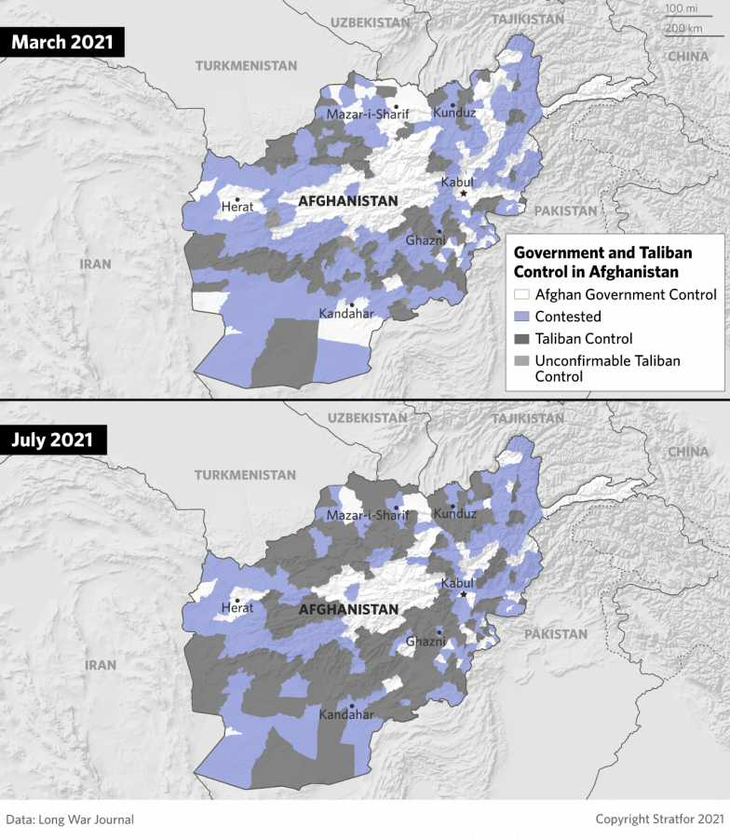The rapid withdrawal of foreign troops from Afghanistan, combined with the Taliban’s recent territorial gains, will create a power struggle between the Taliban and the Afghan government that will likely cause a civil war and further degrade the regional security environment. The Sept. 11 deadline for the withdrawal of U.S. troops announced by President Joe Biden has become a symbolic timeline. On the ground, more than half of U.S. and NATO troops have left Afghanistan, and reports suggest remaining troops will leave the country as soon as the first week of July. On July 2, U.S. forces finished withdrawing from Bagram, their main military base in Afghanistan. Taking advantage of this strategic opportunity where Afghan troops are solely responsible for the security of the country, the Taliban launched an offensive campaign to capture and control territories, almost as soon as May 1 when foreign troop withdrawal began. The Taliban has since taken control of 157 districts of Afghanistan’s 407 districts in just two months.
On June 29, Taliban fighters launched an attack on Ghazni, a critical city along a highway linking Kabul with the southern province of Kandahar. If the Taliban manages to take over the city, it would mark a second major territorial gain by cutting movement to and from the south to Kabul. First was the capture of Doshi, a district home to the only road linking Kabul to northern parts of the country earlier on June 21st.
The Taliban also has control of checkpoints in the northern Kunduz province bordering Tajikistan, giving it control of a major trade route into Central Asia.
Aside from expanding on-the-ground influence for its own sake, territorial gains give the Taliban strategic bargaining chips to gain more leverage in future negotiations with the Afghan government.
The Stalled Afghan Peace Process
The withdrawal of troops was one of the main conditions in the agreement that the United States reached with the Taliban in February 2020. In exchange, the Taliban agreed to ceasefire and participation in talks with the Afghan government in Kabul in order to reach an Afghan-led and Afghan-owned solution to political and security issues plaguing the country. But those intra-Afghan negotiations have been stalled over the two sides’ conflicting pre-qualifications, with the Taliban demanding that Kabul first release Taliban prisoners and guarantee the group will be fairly represented in a post-war government. The Afghan government, meanwhile, has insisted that it won’t engage in talks with the Taliban until the group agrees to a cease-fire.
Afghan security forces are losing territories due to logistical and political leadership failures. Afghan security forces rely on U.S.-funded contractors to repair and maintain their fleet of aircraft, armored vehicles and other equipment. But those contractors will also leave soon as part of the U.S. withdrawal, leaving Afghan forces unable to maintain dozens of fighter planes, cargo aircraft, U.S.-made helicopters and drones for more than a few more months. This could effectively ground the Afghan Air Force, which is Kabul’s main edge against the Taliban due to its role in supporting Afghan ground operations with effective airstrikes — a capability that the Taliban lacks. There is also a lack of coordination on the ground due to ineffective political leadership in Kabul. Demoralized by limited resources, the U.S. troop withdrawal, low salaries and widespread government corruption, Afghan soldiers have turned over district centers, abandoned military bases and surrendered to the Taliban. They’ve handed over their weapons, vehicles and other war material without a fight due to a lack of numbers and equipment as well. The Taliban offensive in the northern districts also stretched limited Afghan forces across large areas, further weakening them.
The decaying security situation in Afghanistan is likely to incite a chaotic civil war in less than six months after foreign troops withdraw. To help overcome its inability to coordinate an effective Kabul-led military response, the Afghan government recently launched a “national mobilization” campaign, which arms civilians and local militias to counter the Taliban’s advances. But with its structured offensive, the Taliban would still easily defeat local militias due to their relative lack of military training and equipment. Given Afghan militias' long history of shifting loyalties, power struggles and territorial disputes, there’s also no guarantee that local armed groups won’t use the new arms to fight against each other instead of the Taliban, increasing inter-communal violence and unrest. These armed organizations are theoretically linked with the Afghan government, but their organization has the potential to further splinter the war-torn country along ethnic lines and boost the Taliban by default, resulting in a multi-front and multi-party war between the Taliban, Afghan government and local militias.
Warlords heading the militias have provided protection to the ethnic minorities often targeted by Taliban. But while these militia formations have temporarily aided government forces in their fight against the Taliban in many northern regions, they have also bolstered warlord fiefdoms, eroding the government's authority in Kabul that could outlast the current conflict.
Northern Afghanistan could become a fighting ground for Taliban and non-Pashtun groups composed of ethnic minorities like Tajiks and Uzbeks. This violence would further destabilize the country and might lead to migrations and refugee crises in Central Asian countries.
Southern Afghanistan, with a majority Pashtun population, could become a base for al Qaeda and Islamic State militants, as they would have much more operational freedom to conduct a host of activities, including recruitment, training and attack plotting.
An increasingly volatile Afghanistan would also endanger the security of the nearby countries by providing a fertile training ground for regional militant groups. Violent clashes between the Taliban and security forces have resulted in thousands of civilian casualties and internal displacement of people from rural areas to relatively more protected provincial capitals and cities. In the coming months, particularly after the United States and NATO complete their troop withdrawal, major cities could also fall to the Taliban. Such Taliban gains could trigger a regional humanitarian crisis that would be difficult to address amid the violence, thus presenting a sustained threat of unrest. A security vacuum and a stronger Taliban could also foster a revival of training camps of various terrorist groups in the Afghanistan hinterland, further endangering the security of the entire region. In addition, international and regional terrorist organizations could mobilize and operate from the region to threaten the security of South and Central Asia. A strong foothold in Afghanistan could enable al Qaeda and the Islamic State to plan operations against the West as well.
Tehrik-i-Taliban in Pakistan (TTP) based in the Afghanistan-Pakistan border region could intensify attacks against Pakistan, which could, in turn, provoke Islamabad to increase its meddling in Afghanistan. There are 5,000 TTP fighters in the Afghanistan-Pakistan border region, suggesting the group is primed to take advantage of increased Taliban control and scattered Afghan forces focused on operations against the Taliban.
Terrorist groups operating against India like Jaish-e-Mohammad (JeM) and Lashkar-e-Taiba (LeT) would have more strategic depth to carry out their offensives in the region due to their links with the Taliban. Attacks on India could drive India to intervene against these groups in Pakistan and Afghanistan as well.
Al Qaeda may reboot in Afghanistan once the Taliban — which it has reportedly maintained close ties with — overwhelms Afghan security forces. An Islamic State resurgence in Afghanistan also cannot be ruled out, as the group has proven resilient and has asserted some level of presence and control in southern parts of the country. Both of these developments would present a significant increase in the terrorism threat to the West, given that al Qaeda and the Islamic State both maintain a strategic intent to use an Afghan safe haven to strike targets abroad.

How to get your free month
How pricing works
How to view posts
What you can post
A #podcast about #persuasion, #deception, #communication, and the #Grayman
https://promocards.byspotify.com/share/5e3dfefd944d823be992a43447470e279711b635
These are some of my favorite camping tips A #podcast about #preparedness, #camping, #hiking, and the #Grayman
https://spotifyanchor-web.app.link/e/umedj5kJiBb














